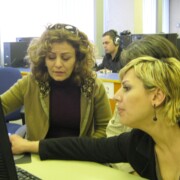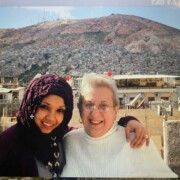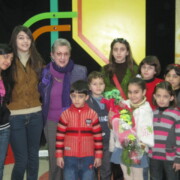
Arab nations, led by Egypt, and renowned through the excellence of Al- Jazeera TV Network, have an established tradition in journalism, although the degree of professionalism varies from country to country. In Syria while news reporting is limited, there exists a thriving and highly respected television drama industry. From about 2000, Syrian dramas were in great demand across the Arab world, rivaling their Egyptian counterpart.
News reporting was wanting however. A basic skill all Arab media directors sought to build among their production staff was brevity. This was especially so in television and radio broadcasting. Thus B.N. Aziz was invited to share skills in preparing news clips and short features. She prepared two workshops– “The Art of Interviewing”, and “Short Features for Radio”– for radio and TV professionals at the Pan-Arab Media Centre in Damascus. (see photos under Damascus, Syria.)
Because of the success of those courses, she was invited to adapt the “short features” course into a handbook for The Center’s future use and for wider distribution. Released in 2011, its chapters include: Character and Potential of Shorts; What’s The Story? Sound Gathering; Composing the Story; Editing; and Archiving. (See Excerpts below). It was published by Arab States Media Centre for Radio and Television, Damascus, Syria in Arabic with an accompanying English CD digital translation.
Radio Interview
Arab American writers are a common feature on radiotahir.org. On March 10, 2021, to celebrate Women’s History Month poets Mohja Kahf and Naomi Shihab Nye are featured, drawing from our Radio Tahir archive.
Photos
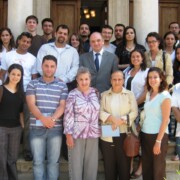
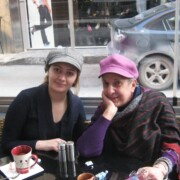
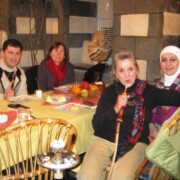
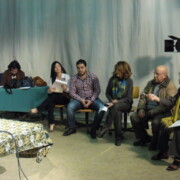
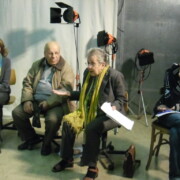

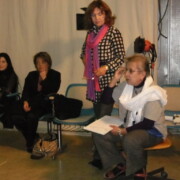
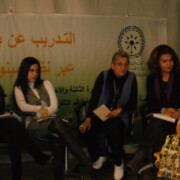
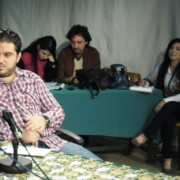
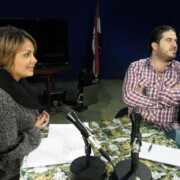


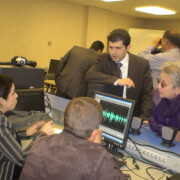

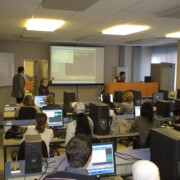
Excerpts
Introduction
Today we live in a modern world where media work is more competitive, and where innovations oblige us to constantly learn new technical skills. Not only this; radio now competes for peoples’ time against TV, against online broadcasting and against print media. Phone and internet sources are essential for transmission.
Across the world, people generally listen to radio programs on a sustained basis far less than they tune in to TV and online broadcasts. Yet, radio survives. It survives because o the special qualities of ‘sound’ so our producers face the challenge of keeping radio appealing and strong on a daily basis and innovating in order to maintain its influential in the future.
The Short Feature is one of many popular formats available to a producer. We stressing this mode because of its potential in Arab culture. In our culture, an extended format is often the preferred format. But ‘long’ may not be competitive and ‘long’ may not always be the most effective means of conveying an idea and information.
One does not often hear short productions in Arab radio. But it has its place in any medium, and it has its intrinsic value. We need to learn this mode of production; it can be achieved by adopting basic principles and with practice.
Collecting Sound & Composing Story
While you gather background information, you will be arranging interviews with ‘ordinary people’. They will draw on personal experience to explain a subject.
First, after preliminary review with your guest, you have decided on your ‘story’ subject–your point-of-view. Then you and your team compile a list of sources you need. This can consist of an interview with a main guest, e.g. a manager. Then you carry out library research, perhaps consult a responsible city or a state government department. These sources will provide you with background data and the statistics you need to write your narrative.
An example: If your story is about the economic viability of shopping malls in Damascus, you will need to know the most basic facts: when the first mall was built, how many there are today, what were the initial investments, how the location was chosen, competition among businesses seeking to rent space in the mall, etc.
Next you will want 2 or 3 face-to-face interviews (not more than 3) for a Short Feature. For the shopping mall feature, one interviewee may be an architect who designs these centers, another, the operator of a store in the mall, a third, one of the initial financial investors.
Composition
In Chapter 3 we discussed various forms a Short Feature can take: the format can be pure narration, a poem, or a single Q & A interview. Each format calls for different skills.
The format we focus on in this course is the one that combines background narration and live clips (actualities) from your interviews. (Interviewing is an essential part of this production.) This format is like a news report. It consists of: a) the lead; b) an introduction/narration; c) background sound; d) one actuality; e) 2nd narration; f) another actuality; g) 3rdnarration and perhaps an additional actuality; finally h) sign off.
A very short clip of music can be selected for insertion at beginning and the end of the feature.
Research can take considerable time especially early in a series of short features.
Writing is also time-consuming. Note: radio-writing is distinct from writing for print media. Keep sentences short and simple. Learn the skill of writing for radio.
Materials you collect for your narrative should be up-to-date and presented in condensed form. E.g. A story on shopping malls may begin: “Syria opened its first shopping mall in 2005 in Damascus. (Today there are xx malls across the county.) Many people believed such places would be unable to compete with malls in Dubai where wealthy Syrians often shop. But events have proved otherwise; even before construction on Syria’s first mall was complete, all commercial space in the mall was rented out. Rental rates of xxxx per square meter in 2004 have risen to xxxx per sq. m. today. Mr. AAAA is a store owner who signed a contract for 40 sq. meters in 2004. (This will lead to your first actuality.)
القصيـر
1- مقدمة:
الفيتشر الإذاعي: يستخدم الصحفيون الإذاعيون هذا الشكل الإذاعي لإعطاء خلاصة أو لمحة عن حالات معفدة ، جاعلين القصة بذلك أوضح وأكثر قابلية للفهم .
في هذا النمط يخبر المعد قصصاً عن أناس يشعر المستمعون بأنهم يمتون لهم بصلة.
ويستطيع الصحفيون رسم أي قضية معقدة باستخدام الفيتشر، فهو شكل حر وخلاّق إلى أبعد الحدود،وباستخدامه أنجزت بعض أبرز البرامج الإذاعية وأكثرها إبداعاً.
مثال: إن قام البرلمان بتمرير قانون جديد عن المعاش التقاعدي فإن الفيتشر الإذاعي يمكن أن يعرّف المستمع بأحد الأناس المتقاعدين ويصف تأثير القانون الجديد عليه .
ويتم عمل ذلك باستخدام الأصوات والمقاطع الصوتية للناس (المسامع) والصوت المحيط والموسيقى …إلخ، ويتم تجميع ذلك كله في طريقة فنية ومنظمة بعناية.
في الفيتشر الإذاعي يمكنك أن تصادف كل الأنواع ، الشعر ، الموسيقى، الأصوات،أصوات الشارع،أصوات الطبيعة،وجميعها تتحد معاً لتزود المستمع بالمعلومة ولتنقله إلى عالم آخر ، او لتقدم له الإلهام.
والفيتشر بخلاف المسرحية يجب أن يقنع المستمع في الجانب الذي يتحدث فيه.
فعند تقسيم الموضوع المعقد إلى أجزاء وفق مستوى الناس العاديين يتشكل لدينا ما يعرف بخلاصة الموضوع، وبخلاف ذلك فإن التقرير الإذاعي العادي يركز بشكل أكبر على التفاصيل ، كأن نستمع فيه مثلاً إلى تفاصيل جدال دار ضمن البرلمان حول قانون جديد.
ولفهم ماهية هذا النوع من الأشكال الصحفية علينا أن نستمع إلى فيتشر.
بالإضافة إلى روح الإبداء أثناء التخطيط له فإنه يحتاج منك إلى الصبر أثناء التنفيذ وإلى عمل مكثف ، فالفيتشر مادة مستهلكة للوقت بشكل كبير ، لذلك فإن كثيراً من الصحفيين يعتبرون “الفيتشر” صنفاً قائماً بذاته في الصحافة الإذاعية.
Related Articles
April 26, 2018, Counterpunch.org If there’s any argument against our excessive reliance on digital platforms to maintain social fabric, it is surely found inside Iraq…
May 31, 2005, Towards Freedom In the long struggle between Iraq and the US, Iraqi women have been the most harmed of that nation’s beleaguered…
Originally published in Ceramics Monthly, Illustrated. March, 1993. Tibet’s otherwise bleak, brown land scape is sometimes broken by rust-colored hillocks. Located just beyond the mud…
Published in Ceramics Monthly, March 1993. By Barbara Nimri Aziz. Tibet’s otherwise bleak, brown land scape is sometimes broken by rust-col- ored hillocks. Located just…
Originally published in The Tibet Journal, Vol XII, no 4. Dharamsala. 1987 Sociology of Tibet can begin with a study of its women and its…
Originally published in KAILASH, A Journal of Himalayan Studies, Vol IV. 2. 1976

